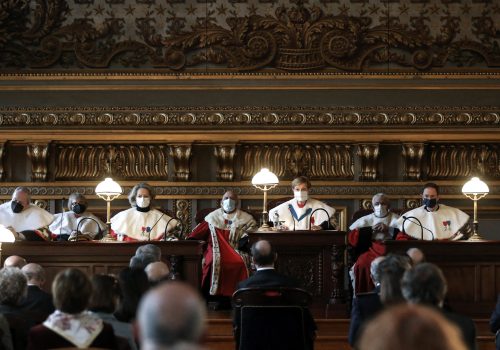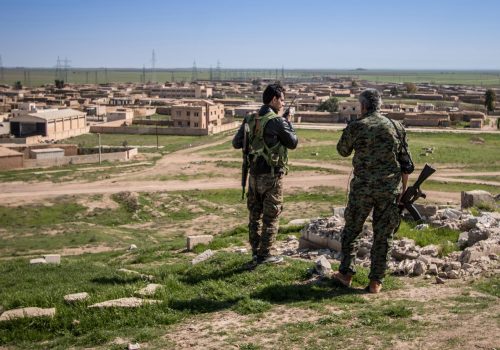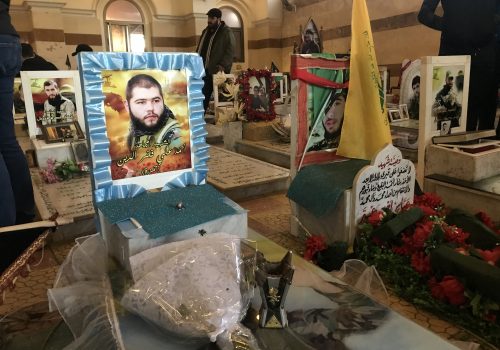How a former al-Qaeda affiliate became an existential threat and a wake-up call for the Syrian opposition
On October 11, infighting between Turkey-backed armed forces in northern Syria opened the gateway for Hayat Tahrir al-Sham (HTS), a former al-Qaeda affiliate and designated terror organization, to enter Afrin city and temporarily occupy northern Aleppo province. With this move, HTS showed force for the second time in four months. In contrast to Idlib province, where HTS dominates the ground, Afrin was considered to be under the control of the Syrian National Army (SNA) after the Turkish-Syrian military operation in 2018, leading Turkey to proclaim Afrin a safe zone. The entry and forced withdrawal—due to a Turkish ultimatum—shook local dynamics and may ultimately serve as a wake-up call for the Syrian opposition.
Since 2018, the region of Afrin in northern Aleppo has seen significant change; the predominantly Kurdish region was no longer controlled by the People’s Protection Units (YPG)—the Syrian branch of the Turkish Kurdistan Workers’ Party (PKK)—but the SNA and Turkish Armed Forces. With this, a new governance model was implemented in the region, where local councils governed over local affairs, including infrastructure and internal security. While all local councils are nominally bodies of the Syrian Interim Government (SIG), the adjacent Turkish governate of Hatay played a significant role in an official advisory capacity.
However, the most significant change came in terms of demographics. While a big portion of the initially displaced Syrian Kurds returned to Afrin, the demographics of Afrin have started to alter through different dynamics. Until the end of 2018, the Bashar al-Assad regime, backed by Russia and Iran, captured opposition strongholds in Ghouta, Darayya, Qalamoun, Homs, and Daraa. Syrians who refused to live under Assad were deported to northern Aleppo as part of an agreement signed between rebels and the regime. With these surrender agreements, the rural region of Aleppo received thousands of new urban and Arab internally displaced persons (IDPs) via the notorious green buses, turning Afrin into a new shelter for them.
Additionally, a second migration dynamic happened to Afrin. While less in quantity, it was politically more significant. After HTS began to dominate part of Idlib province south of Afrin, many activist, political, and military figures had to flee for their safety.
With the new IDP flows, Afrin turned from a predominantly Kurdish region into a mix of Kurds and Arabs. However, the SNA—mainly Jabhat al-Shamiyah, the biggest military faction of the SNA that stood up for the rights of Kurds in Afrin—deployed in the city was predominantly Arab. The group led efforts to restore rights to locals and managed to get other factions to approve of them. Syrian Kurdish commanders in Jabhat al-Shamiyah played an important role in reaching out to local Kurds. On the other side, the leader of the Sultan Sulaiman Shah military faction, Abu Amsha, was convicted by Syrian judges for crimes against the local people. However, the decision was never implemented.
HTS’ entry into Afrin
To the south of Afrin, HTS had other expansion plans. In the beginning of 2022, it reached out to rivals of Jabhat al-Shamiyah, who feared that the group might dominate them. Before, HTS used its dominance in Idlib province to plot a coup inside its former rival, the Ahrar al-Sham military faction, and help figures close to HTS to be in charge. In June, when infighting broke out between Jabhat al-Shamiyah and Ahrar al-Sham in northern Aleppo, the latter called HTS for aid. HTS advanced swiftly but had to return the next day after an agreement was signed with Jabhat al-Shamiyah.
However, the agreement did not guarantee that HTS would not try again. During the latest infighting in northern Aleppo in October, HTS used its new outreach with the rivals of Jabhat al-Shamiyah and re-entered Afrin. For this purpose, HTS reached out and established a relationship with the isolated Sultan Sulaiman Shah and Firka Hamza military factions of the SNA in northern Syria. Based on these ties, HTS was able to intervene again and ended up staying. The group established its internal security structure, cleaned the streets, and attempted to reach out to the local community. In negotiations with Jabhat al-Shamiyah, HTS demanded the end of governance by the Syrian Interim Government and requested a unified governance structure of the Salvation Government—the civil face of HTS for governance in Idlib.
Even though HTS controlled Afrin, its push toward the city of Azaz was blocked. Despite heavy fighting, Jabhat al-Shamiyah resisted for days and prevented its entry to Azaz. During those days in mid-October, demonstrators demanded the withdrawal of HTS to Idlib and rejected its possible entry into their towns.
After the fighting reached a stalemate, Turkey reportedly issued an ultimatum on October 17 that demanded HTS fully withdraw from Afrin, pushing HTS to finally leave and prevent the takeover of the rest of northern Aleppo province. However, reporting from the ground in Afrin claimed that HTS-led cells and disguised personnel continue to stay behind. Nevertheless, with the support of Turkey, the civil police of the local councils and military police of the SNA continue their search for possible cells. Apparently, the efforts were successful so that civilians in Afrin could go out and demonstrate against HTS. Furthermore, to prevent HTS from re-entering again, the Turkish army reinforced barriers that separated Afrin from Idlib.
Survival of radicals versus survival of the Syrian opposition
At first glance, with these incursions, the leader of HTS, Mohammad al-Jolani, appears to be a pragmatic jihadist or an opportunistic warlord. However, in reality, the motives are more related to survival than opportunism.
The current relative calm in Syria—due to the Turkish-Russian ceasefire agreement on 5 March 2020, Turkey’s relative success in preventing military control of Idlib province, and Russia’s occupation of Ukraine—is illusive. Jolani knows this. To survive, the HTS leader wants to dominate the entire opposition-held areas of Syria and gain a position of indispensability. Knowing that Turkey can’t risk another refugee flow and therefore can’t withdraw from Syria, HTS aims to force itself as the only alternative upon international actors in the West and Turkey and be delisted from the designated terrorist list of respective countries.
In contrast, for Syrians who continue to support the aspirations of the 2011 Syrian revolution, this means their last hold in Syria is endangered. The inter-factional dynamics created an Achilles’ heel that can be exploited by an actor vertically opposed to those aspirations. The latest incursion of HTS into Afrin may be a strong warning to Syria’s political and military actors to correct the course of action. Now, public opinion has been awakened by the potential danger from Idlib. The continuity of the public demonstrations can shift local dynamics and have already started a discussion about improving conditions and governance structures in northern Aleppo.
Local Syrian Kurds and the internally displaced in Afrin will have to work hand-in-hand to oppose three enemies simultaneously: the Assad regime, YPG, and HTS. The factions of the SNA also need a systematic solution to their infighting and rivalries, which make them vulnerable. In retrospect, the belated ultimatum by Turkey helped overcome ignorance and appears to be working as a sort of wake-up call. The ultimatum provided local dynamics with time and a new understanding of the need to improve capabilities and conditions. It is now time for local actors to work on it and for state actors to support these local actors.
Ömer Özkizilcik is a foreign policy and security analyst based in Ankara. Follow him on Twitter: @OmerOzkizilcik.
Further reading
Thu, Feb 10, 2022
A perpetrator of Syrian crimes against humanity went free in France. Here’s why it shouldn’t happen again
MENASource By Michel Duclos
If the scope for changing the course of events in Syria is limited, it’s honorable to take a stand against the abominable crimes of the Bashar al-Assad regime. It would be a great pity for France to be seen as a safe haven for Assad’s accomplices.
Fri, Sep 3, 2021
Afghanistan demonstrates why it’s time for a clear Syria policy, starting with northeast Syria
MENASource By Reem Salahi
If Afghanistan is to teach us anything, the Biden administration should not ignore Syria by having a non-existent policy. The longer the Syrian conflict continues, the more intractable and unmanageable it becomes.
Mon, Jul 20, 2020
Amidst the pandemic, Hezbollah buries fighters killed in Syria
MENASource By
Multiple additional combatant deaths have been reported by media outlets close to Hezbollah since the COVID-19 lockdown, pointing to its continued engagement in military combat and training activities.
Image: Fighters of Hay'at Tahrir al-Sham (Levant Liberation Committee or HTS) opposition militant group take part in a military exercise with live ammunition at a training camp in Idlib Province. via Reuters


